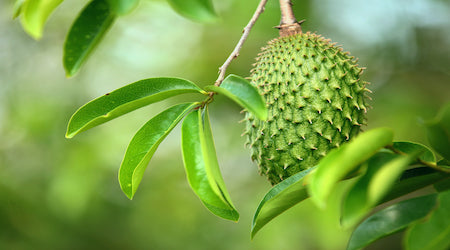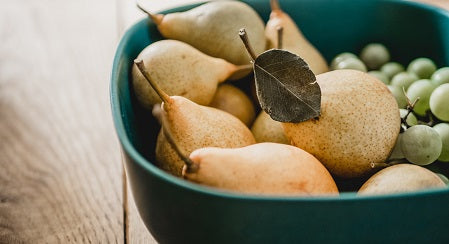
Nos actifs 23/11/2020
Coup de projecteur sur un fruit exotique hors du commun : le Graviola
Au Brésil, on l’appelle Graviola. Sur l’île de la Réunion, Sapotille. En Inde, Sapadille. Au Vietnam, Mang-Cau. En Thaïlande, Thu-Riankhaeek. En Espagne, Guanabana. Autant de noms qui désignent le fruit du Graviola, appelé aussi Corossolier. Cet arbuste des forêts tropicales d’Afrique, d’Amérique et d’Asie est apprécié par la médecine traditionnelle pour ses nombreuses vertus. Son fruit, ses feuilles, ses racines, son écorce mais aussi ses graines déploient des trésors pour la santé du corps et de l’esprit. Depuis plusieurs décennies, les bienfaits du graviola mobilisent les scientifiques. Tour d’horizon d’un fruit exotique pas comme les autres.
Le fruit
Sur ce petit arbre à feuilles brillantes pousse le graviola. En forme de cœur, c’est un fruit comestible reconnaissable à son écorce verte foncée piquée de petites épines. Il est assez imposant puisqu’il peut mesurer jusqu’à 30 centimètres et peser entre 1 et 5 kilos. Sa chair est blanche et renferme des graines noires. Au-delà de ses vertus thérapeutiques, le graviola est utilisé en cuisine pour son jus à la fois sucré et acidulé, qui rappelle le goût du litchi ou de la mangue.
Usages traditionnels
Sous les tropiques, là où il pousse, le graviola est consommé depuis très longtemps par les indigènes pour ses nombreuses propriétés thérapeutiques. Toutes les parties de l’arbuste y sont utilisées : le fruit, l’écorce, les feuilles, les racines et même les graines. Le fruit et son jus sont consommés notamment contre les vers et les parasites, pour faire baisser la fièvre, pour augmenter la sécrétion de lait maternel, ou comme astringent dans les diarrhées et les dysenteries. L'écorce, les feuilles et les racines sont considérées comme sédatives, antispasmodiques, hypotensives, et luttant contre les troubles nerveux.
Dans les Andes péruviennes, on boit la tisane des feuilles contre les catarrhes (inflammation des membranes muqueuses) et les graines sont broyées contre les parasites.
En Amazonie, l’écorce, les racines et les feuilles sont utilisées comme sédatifs et antispasmodiques, ainsi que contre le diabète.
Les indigènes du Guyana consomment la tisane des feuilles et/ou de l'écorce comme sédatifs et tonicardiaques.
Au Brésil, la tisane des feuilles est prise contre les désordres du foie. L'huile des feuilles et le fruit vert sont mixés avec de l'huile d'olive et appliqués en usage externe contre les névralgies, les rhumatismes et les douleurs articulaires.
A la Jamaïque, à Haïti et aux Indes Occidentales, le fruit et son jus sont consommés en cas de fièvre, de parasites et de diarrhée. L'écorce ou les feuilles sont préparées en tisane et utilisées comme antispasmodiques, sédatifs, stimulants cardiaque, contre la toux, la grippe, l'asthme et l'hypertension.
Propriétés et bienfaits du graviola
La chair du graviola se compose essentiellement d’eau (80%). Très énergétique, elle contient des glucides (principalement du fructose), des vitamines (C, B1, B2), des protéines, des sels minéraux (potassium, fer, phosphore), des acides aminés, des alcaloïdes et des fibres.
De par sa richesse nutritive, le graviola participe à soutenir l’organisme de différentes façons :
-
C’est un puissant diurétique
-
Il abaisse la tension
-
Il aide à stabiliser le taux de sucre dans le sang
-
Il détoxifie l’organisme en boostant les capacités du foie et facilite le transit intestinal
-
Il agit comme un antispasmodique, anti-diarrhéique et antiparasitaire
-
Il aide à lutter contre la fièvre, les troubles du sommeil, le stress et les états dépressifs
-
Il a une action contre les virus, les herpès, les microbes, les maladies anti-inflammatoires, certaines maladies cardiaques et hépatiques.
Par ailleurs, depuis plusieurs décennies, une spécificité du graviola intéresse la communauté scientifique : les acétogénines contenues dans ses feuilles. Ces acétogénines sont des composés phytochimiques exclusivement présents chez les espèces de la famille des Annonaceae et auraient des propriétés anti-tumorales.
Le graviola sous la loupe des scientifiques
Les principes actifs de ce fruit exotique occupent les scientifiques depuis 1940, avec plus d’une centaine de programmes de recherche aux États-Unis, en Inde, au Japon, en Corée et en Europe. Les études publiées ont mis en évidence ses propriétés antimicrobiennes, antivirales, anti-inflammatoires, antidiabétiques, antihypertenseuses, antiparasitaires, insecticides, ou encore hépatoprotectrices. Une revue complète des vertus du graviola a d’ailleurs été publiée en 2015 dans une méta-analyse menée à la Faculté des Sciences de Kuala Lumpur en Malaisie. Mais la plupart des recherches se concentrent sur les composés chimiques présent dans le fruit, et surtout dans les feuilles : les acétogénines.
Antibactérien, anti-infectieux et antiviral naturels
Le graviola possèdent de nombreuses propriétés antivirales, antimicrobiennes, antibactériennes et antifongiques, permettant de lutter contre les parasites et les infections intestinales, mais aussi contre certains virus qui s’attaquent à l’organisme.
Renforce le système immunitaire
Riches en antioxydants, les feuilles de graviola favorisent l’élimination des radicaux libres. Ses acétogénines préservent l’organisme de l’oxydation des cellules, prévenant ainsi le développement de certaines maladies.
Action diurétique
Les propriétés diurétiques des feuilles de graviola participent à drainer les reins, favorisant ainsi l’élimination des toxines et des déchets. Elles participent également à la destruction des bactéries présentes dans la vessie et les canaux urinaires.
Antidiabétique
Les acétogénines présentes dans les feuilles de graviola aident à stabiliser le taux de sucre dans le sang et ainsi à prévenir l’apparition du diabète. Elles favorisent également la production d’insuline dans l’organisme, empêchant les pics de glycémie.
Anti-inflammatoire
La capacité des feuilles de graviola à réduire l’inflammation en fait un allié pour ceux qui souffrent de rhumatisme ou d’arthrite. En effet, elles ont la capacité d’évacuer l’acide urique du sang, permettant ainsi de soulager les douleurs articulaires et de traiter le syndrome de la goutte.
Soutient la digestion
Les nombreux alcaloïdes présents dans les feuilles de graviola soutiennent l’organisme contre les ballonnements, les diarrhées, les irritations gastriques et la mauvaise digestion. Ils permettent de dissiper les douleurs au foie et à l’estomac et favorisent l’élimination de substances chimiques, comme la cortisone ou les médicaments toxiques.
Troubles du sommeil et anxiété
Les feuilles de graviola contiennent une forte teneur en tryptophane, une molécule qui agit sur la sérotonine. Ses vertus apaisantes soutiennent le système nerveux, permettant de diminuer le stress et l’anxiété et de favoriser l’endormissement.
Anti-cholestérol
Les feuilles de graviola offrent des propriétés hypocholestérolémiantes. Elles permettent donc de réduire l’incidence du mauvais cholestérol dans l’organisme.
Potentielles propriétés anti-cancer des acétogénines
De nombreuses études effectuées depuis 1970 ont montré le potentiel des acétogénines. Les acétogénines du graviola seraient bien plus concentrées et efficientes dans les feuilles que dans le fruit. Ces molécules participeraient à la destruction des cellules tumorales de plusieurs types de cancer, y compris le cancer des ovaires, du sein, de la prostate, des reins, du pancréas, des poumons, du foie et des intestins.
Les recherches ont montré que ces principes actifs seraient capables d’induire l’apoptose des cellules cancéreuses, c’est-à-dire leur mort autoprogrammée. Les propriétés des acétogénines ont été notamment étudiées par le Professeur américain Jerry L. McLaughlin de l’université de Purdue dans l’Indiana. Dans une étude publiée en 1996, il affirme que certaines acétogénines du graviola sont « 10'000 fois plus puissantes sur des cellules du cancer du côlon » que les produits couramment utilisés en chimiothérapie cancéreuse. En 1999, la faculté de médecine de l’Université catholique de Corée a de son côté remarqué que les acétogénines détruiraient les cellules atteintes du cancer mais épargneraient les cellules saines. Jerry MacLaughin poursuit ses travaux avec son équipe et découvre en 2000 que les composants actifs du graviola fonctionnent en bloquant les sources d’énergie des cellules cancéreuses. En 2003, des chercheurs de Taïwan ont découvert que la principale acétogénine du graviola, l’Annonacine, était hautement toxique contre certaines lignées de cellules cancéreuses, notamment celles du sein, de la prostate, du foie, du cerveau et de la peau. Depuis, d’autres Universités ont complété ces recherches et publié des travaux autour du pouvoir des acétogénines dans plusieurs types de cancers, notamment ceux du poumon, du sein, du pancréas, du foie et de la prostate.

Les feuilles de graviola ont-elles des propriétés dangereuses pour la santé ?
Certaines études scientifiques ont émis quelques doutes sur une possible corrélation entre la maladie de Parkinson et une consommation importante de feuilles de graviola. Les recherches se sont penchées sur la question des alcaloïdes contenus dans les feuilles de graviola, susceptibles d’être toxiques à fortes doses. Les alcaloïdes sont des neurotoxines qui à très fortes doses pourraient entraîner des maladies neurodégénératives.
Comme la plupart des autres fruits ou plantes, le graviola ne déploie tous ses bienfaits que dans le cadre d’une posologie adaptée, et donc d’un dosage correct. Il est donc judicieux de respecter la posologie des produits que vous achetez, ainsi que la durée de la cure. En cas d’antécédents de parkinson, n’hésitez pas à en parler à votre médecin.
Comment consommer le graviola ?
Le graviola peut se consommer en fruit, en jus, en sorbet, en infusion de feuilles, en poudre ou sous forme de compléments alimentaires. L’avantage des gélules est qu’elles permettent d’obtenir un dosage précis et sécurisé dans le cadre d’une cure de supplémentation alimentaire.


